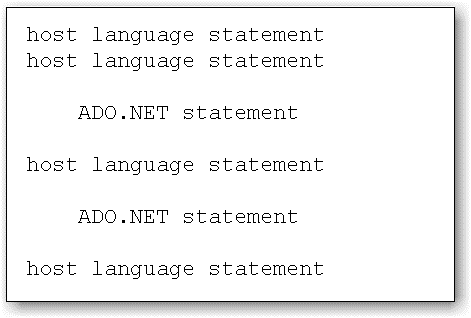ADO.NET
ADO.NET provides the database access for Microsoft.NET. XML is used in ADO.NET for in-memory middle-tier business objects, or DataSets, built at run-time from EIS-tier databases. The DataSets are a copy of the data in the database and are not actively connected to the underlying databases. This is referred to as a "disconnected" view of the database data. ADO.NET is designed to work with all the languages supported in .NET. ADO.NET can be used with virtually any database management system.
ADO.NET uses the call-level approach. This is illustrated by the ADO.NET statements in this diagram:

An example of a host statement in C# that creates a new Person instance, or DataRow, would be:
DataRow row = ds.Tables["Person"].NewRow();
row["ssan"] = "999999999";
row["name"] = "Doug Barry";ds.Tables["Person"].Rows.Add(row);
If you also wanted to manipulate this new Person instance in the host program, you would need C# code in addition to this code fragment that populates the instance in C# along with the instance in the database.
Context for ADO.NET
Related Articles for ADO.NET
Author
Douglas K Barry
Principal
You may use this material for your work or classes. Reprint Policy. Be sure to check the menu at the left for other articles available on this site.
The Savvy Manager's Guide
Douglas K Barry is also the author of a book that explains Web Services, service-oriented architecture, and Cloud Computing in an easy-to-understand, non-technical manner.
Web Services, Service-Oriented Architectures, and Cloud Computing: The Savvy Manager's Guide (Second Edition)
by Douglas K Barry with David Dick
This is a guide for the savvy manager who wants to capitalize on the wave of change that is occurring with Web Services, service-oriented architecture, and—more recently—Cloud Computing. The changes wrought by these technologies will require both a basic grasp of the technologies and an effective way to deal with how these changes will affect the people who build and use the systems in our organizations. This book covers both issues. Managers at all levels of all organizations must be aware of both the changes that we are now seeing and ways to deal with issues created by those changes.

